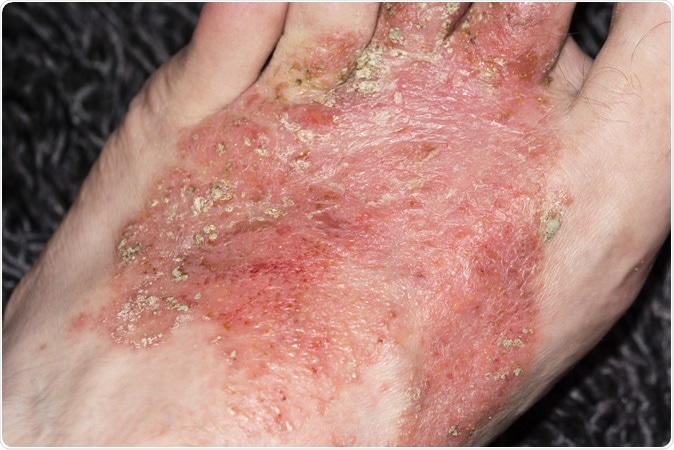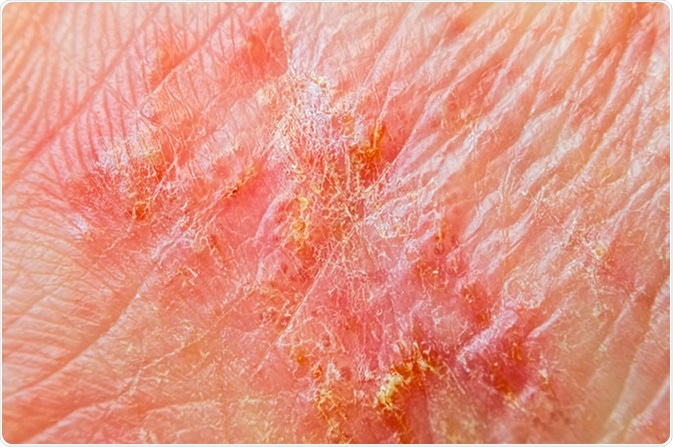Skip to:
Eczema is a skin condition that causes the skin to become red, cracked, dry, and very irritated. There are many different forms of topical treatment for eczema and its related skin conditions. The anti-inflammatory effects of nitric oxide may be useful as a preventive and therapeutic agent for skin conditions such as eczema.

Eczema on the foot - Image Credit: Lapis2380 / Shutterstock
What is nitric oxide?
Nitric oxide (NO) exists naturally as a colorless gas. NO is a signaling molecule in humans and other mammals, that plays a key role in many important physiological functions within the body. NO is generated from nitrite or by the oxidation of ammonia; however, the urea cycle is the main process that synthesizes NO in mammals. There are two nitric oxide synthases (NOSs) that are responsible for the production of NO: cNOS (which is a Calcium-dependent enzyme) and iNOS (which is a Calcium independent enzyme). NOS enzymes are heavily regulated to tightly control the signaling that NO can perform.
NO can diffuse freely through the plasma membrane of cells which allows it to signal extremely quickly. NO can target Cu-Fe proteins within cells, causing the release of Cu2+ and Fe2+, and generating O2- and OH free radicals. This results in oxidative injury.
Research has shown that NO is important for functions within several body systems; including the central nervous system, gastrointestinal system, reproductive system, immune system, respiratory system, and the cardiovascular system.

Macro shot of hand eczema. Image Credit: Ana-Maria Tegzes / Shutterstock
Treatments for eczema and other skin conditions
Common treatments for dermatitis include topical emollients, topical corticosteroids, antihistamines (for itching), and wound dressings to allow skin healing.
Topical emollients can come in various strengths depending on the severity of an individual's dermatitis. Ointments can be used for very dry skin, lotions for less dry skin, and emollients can be added into the bathwater or even used as soaps. Each of these contains different amounts of oils which each patient will respond differently to.
Various corticosteroids can be used depending on the severity of the dermatitis being treated. Examples of this are that mild dermatitis can be treated using hydrocortisone, moderate dermatitis can be treated using clobetasone butyrate, and stronger forms for dermatitis can be treated using mometasone.
Using nitric oxide to treat eczema
Nitric oxide (NO) release has been demonstrated to have beneficial effects with inflammatory conditions. This has led to an increased focus on developing NO-releasing anti-inflammatory medications in recent years.
A recent study evaluated the preventative and curative effects of a NO-releasing hydrocortisone derivative (NCX 1022) on inflammatory skin conditions such as eczema. This study exposed contact dermatitis mice models to either hydrocortisone, NCX 1022, or a vehicle control. These mice were further split into two groups for each treatment, with a pre-treatment group (topical treatment applied 15 mins before exposure to an irritant) and a post-treatment group (topical treatment applied 5 mins after exposure to an irritant).
The results of this study showed that hydrocortisone pre-treatment showed significant improvement to inflammation of the skin after approximately 5 hours after the induction of dermatitis.
The pre-treatment of NCX 1022 reduced inflammation of the skin as quickly as 1 hour after the induction of dermatitis.
Overall these results showed that with pre-treatments, the NCX 1022 was far more effective at reducing the irritation caused by dermatitis for the initial phase of inflammation.
Similarly, to the pre-treatment, the post-treatment of hydrocortisone also showed improvements to inflammation after around 5 hours following the induction of dermatitis.
The post-treatment of NCX 1022 also showed improvement of inflammation after an1 hour of dermatitis induction. The study also showed that both treatments were effective at reducing the damage to the tissue architecture caused by the induction of dermatitis.
It is clear that NCX 1022 had a shorter time to efficacy for both the prevention and treatment of dermatitis when compared with hydrocortisone. The results also expressed that the effectiveness of NCX 1022 was dose-dependent, with higher doses of NCX 1022 providing a better anti-inflammatory effect.
A different study aimed to assess the possible treatment effects for dermatitis when treating human regulatory T (Tregs) cells with NO. UVB irradiation can cause damage to the skin and lead to dermatitis.
This experiment aimed to find an approach that can reduce this. This experiment involved treating human CD4 T cells with a NO-donor (NOC-18). This led to an increase in the expression of skin-homing antigens (cutaneous lymphocyte-associated antigen [CLA]) in Tregs. These NO-CD4 T cells showed immunosuppressive effects, which can aid with the inflammation and tissue damage seen with dermatitis and UVB irradiation.
The findings from this study gave great insight into treatments for counteracting the immune responses associated with atopic diseases (I.e. atopic dermatitis).
Further Reading
Last Updated: Jun 19, 2023